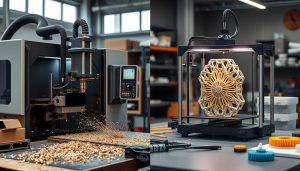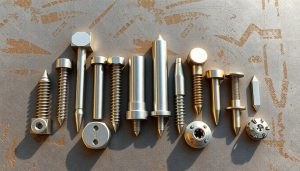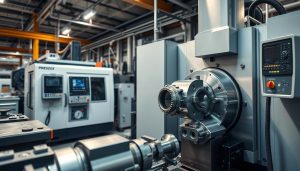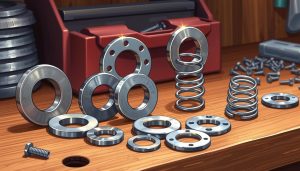In the dynamic world of modern manufacturing, sheet metal fabrication plays a crucial role in shaping the products and components that power a wide range of industries. From the sleek design of consumer electronics to the precision-engineered parts in aerospace applications, the versatility and adaptability of sheet metal fabrication have made it an essential process in the manufacturing landscape.
This comprehensive article delves into the intricacies of sheet metal fabrication, exploring the various techniques, materials, and applications that have transformed the way we design and produce the objects that shape our everyday lives. Whether you’re a seasoned industry professional or a curious observer, this guide will provide you with a deeper understanding of the process that transforms raw metal into the essential components of the modern world.
What is Sheet Metal Fabrication?
Sheet metal fabrication is a versatile manufacturing process that transforms flat metal sheets into a wide range of functional parts and components. At its core, this process involves cutting, bending, and shaping metal sheets to create desired shapes and forms. From the automotive industry to consumer electronics, sheet metal fabrication plays a crucial role in various manufacturing applications.
Definition and Overview of Sheet Metal Fabrication
Sheet metal fabrication is the art of transforming flat metal sheets, such as steel, aluminum, or copper, into intricate and customized parts. This process involves a range of techniques, including cutting, bending, and welding, to create the desired shapes and forms. The final products can vary greatly in size, complexity, and application, making sheet metal fabrication a vital component of modern manufacturing.
Key Materials Used in Sheet Metal Fabrication
- Steel: A versatile and durable material, steel is a popular choice for sheet metal fabrication, particularly in industries like automotive and construction.
- Aluminum: Lightweight and corrosion-resistant, aluminum is commonly used in applications where weight and corrosion resistance are crucial, such as in the aerospace and consumer electronics industries.
- Copper: Known for its excellent electrical and thermal conductivity, copper is often used in the fabrication of electrical components and heat exchangers.
Common Applications of Sheet Metal in Manufacturing
Sheet metal fabrication is widely used across various industries, from automotive and aerospace to consumer electronics and home appliances. The versatility of this process allows manufacturers to create intricate parts, custom enclosures, and complex assemblies that are essential to the functionality and design of their products.
Key Techniques in Sheet Metal Fabrication
Sheet metal fabrication is a dynamic process that encompasses a range of specialized techniques. From cutting-edge methods to time-tested tools, each step plays a crucial role in transforming raw metal into precise, functional components. Let’s delve into the key techniques that are shaping the world of sheet metal fabrication.
Cutting Methods: Laser, Plasma, and Waterjet Cutting
In the realm of metal cutting techniques, laser, plasma, and waterjet cutting stand out as versatile and efficient solutions. Laser cutting, with its unparalleled precision, is ideal for intricate designs and tight tolerances. Plasma cutting, on the other hand, excels at swiftly slicing through thicker materials, making it a popular choice for larger-scale projects. Waterjet cutting, a non-thermal process, offers exceptional control and flexibility, particularly for delicate or heat-sensitive materials.
Bending and Forming: Techniques and Tools
Bending and forming are essential processes in sheet metal fabrication, allowing manufacturers to transform flat sheets into complex, three-dimensional shapes. From press brakes and roll formers to specialized tooling, an array of equipment is employed to precisely bend, fold, and form the metal to desired specifications. These techniques are instrumental in creating everything from simple angles to intricate automotive body panels and aerospace components.
Welding in Sheet Metal Fabrication
Welding plays a crucial role in sheet metal fabrication, joining components together to create robust, durable assemblies. From traditional arc welding to advanced techniques like MIG, TIG, and resistance welding, skilled fabricators leverage a wide range of welding processes to ensure the structural integrity and longevity of their projects. Proper welding techniques are particularly critical in industries like aerospace and heavy machinery, where safety and reliability are paramount.
Additional Techniques: Stamping, Punching, and Assembling
Beyond cutting, bending, and welding, sheet metal fabrication also encompasses other specialized techniques. Stamping and punching operations enable the rapid and precise formation of complex shapes, while assembling processes bring together various components to create finished products. These complementary techniques, combined with advanced fabrication tools, allow manufacturers to push the boundaries of what’s possible in sheet metal fabrication.
| Fabrication Technique | Description | Key Applications |
|---|---|---|
| Laser Cutting | Precision cutting using a focused laser beam | Electronic enclosures, medical devices, aerospace parts |
| Plasma Cutting | Cutting through metals using a high-temperature plasma arc | Heavy machinery, construction equipment, metal structures |
| Waterjet Cutting | Cutting using a high-pressure stream of water and abrasives | Intricate designs, heat-sensitive materials, delicate parts |
| Press Braking | Bending metal sheets using a press brake machine | Automotive parts, furniture, architectural elements |
| Welding | Joining metal parts using heat and/or pressure | Structural assemblies, heavy equipment, transportation |
These key techniques in sheet metal fabrication, from cutting-edge methods to time-honored tools, work in harmony to transform raw materials into innovative, high-quality products. By mastering these processes, fabricators can push the boundaries of what’s possible in metal manufacturing, delivering solutions that meet the evolving needs of industries across the globe.
https://www.youtube.com/watch?v=sgjC25kxzqc
Choosing the Right Material for Sheet Metal Fabrication
When it comes to sheet metal fabrication, the choice of material can have a significant impact on the final product. From strength and durability to cost and corrosion resistance, various factors must be considered to ensure the best outcome. In this section, we’ll explore the properties of different metals and guide you through the process of selecting the right material for your specific needs.
Understanding Material Properties: Steel, Aluminum, Copper, and More
The most common materials used in sheet metal fabrication are steel, aluminum, and copper. Each of these metals has unique properties that make them suitable for different applications. For instance, steel is known for its strength and durability, while aluminum is lightweight and corrosion-resistant. Copper, on the other hand, offers excellent electrical and thermal conductivity.
Factors to Consider in Material Selection: Strength, Corrosion Resistance, and Cost
When choosing the right material for your sheet metal fabrication project, it’s essential to consider several key factors, including:
- Strength: The material’s ability to withstand stress and load-bearing requirements is crucial, especially in applications such as automotive parts and industrial equipment.
- Corrosion Resistance: If the final product will be exposed to harsh environments or chemicals, selecting a material with excellent corrosion resistance can extend its lifespan and performance.
- Cost: The overall cost of the material, including raw material, processing, and manufacturing, must be factored into the decision-making process.
How Material Choices Affect the Final Product
The material selection for sheet metal fabrication can have a significant impact on the final product’s appearance, performance, and durability. For example, using a higher-strength steel may result in a more robust and reliable component, while choosing a more corrosion-resistant aluminum alloy could be better suited for outdoor or marine applications. Understanding how different materials influence the final outcome is crucial in ensuring the success of your sheet metal fabrication project.

“The right material choice can make all the difference in sheet metal fabrication, balancing performance, cost, and long-term reliability.”
Applications of Sheet Metal Fabrication Across Industries
Sheet metal fabrication has become an integral part of various industries, showcasing its versatility and adaptability. From the automotive sector to aerospace engineering and consumer electronics, this manufacturing process continues to play a pivotal role in shaping the products we use every day.
Automotive Industry: Parts and Components
In the automotive industry, sheet metal fabrication is essential for producing a wide range of parts and components. Body panels, such as the hood, doors, and fenders, are often crafted using this technique, ensuring a sleek and durable design. Additionally, exhaust systems and structural components like the chassis and frame rely on the precision and strength offered by sheet metal fabrication.
Aerospace: Precision Parts and Assemblies
The aerospace industry demands the highest standards of quality and precision, which is why sheet metal fabrication is a critical component in the manufacturing of aircraft and spacecraft. From the creation of intricate engine parts to the assembly of fuselages and wings, this process allows for the production of aerospace components that must withstand the rigors of flight.
Consumer Products: Electronics and Appliances
Sheet metal fabrication also plays a vital role in the production of consumer electronics and household appliances. The sturdy and lightweight nature of sheet metal materials make them ideal for the enclosures and housings of devices such as televisions, computers, and kitchen appliances. This manufacturing method ensures these products maintain their durability and aesthetic appeal.
Across these diverse industries, sheet metal fabrication continues to be a driving force in the creation of innovative and high-performing products. As technology and consumer demands evolve, the versatility of this fabrication process ensures it remains a crucial component in the manufacturing landscape.
| Industry | Applications | Key Benefits |
|---|---|---|
| Automotive |
|
Durability, sleek design, strength |
| Aerospace |
|
Precision, high-performance, lightweight |
| Consumer Electronics |
|
Durability, lightweight, aesthetic appeal |
The versatility of sheet metal fabrication is clearly demonstrated across these diverse industries, showcasing its ability to meet the unique demands of automotive parts, aerospace components, and consumer electronics. As technology and consumer needs continue to evolve, this manufacturing process remains a crucial component in the production of innovative and high-performing products.

Why Choose Shixinproto for Sheet Metal Fabrication?
When it comes to sheet metal fabrication, Shixinproto stands out as a trusted partner for businesses across a wide range of industries. With our extensive expertise and commitment to quality, we deliver high-quality fabrication services tailored to the unique needs of our clients.
High-Quality Sheet Metal Fabrication Services for Every Industry
At Shixinproto, we pride ourselves on our ability to handle complex sheet metal fabrication projects with precision and expertise. Our team of skilled craftsmen utilizes the latest techniques and equipment to ensure that every component we produce meets the highest standards of quality. Whether you’re in the automotive, aerospace, or consumer products industry, you can count on Shixinproto to provide the quality solutions you need.
Custom Solutions for Complex Projects and Material Choices
At Shixinproto, we understand that one size does not fit all when it comes to sheet metal fabrication. That’s why we offer customized solutions to meet the specific requirements of your project. From selecting the right materials to designing and manufacturing intricate parts, our team works closely with you to ensure that the final product exceeds your expectations. With our expertise in handling a wide range of materials, including steel, aluminum, and copper, we can help you navigate the complexities of material selection and deliver exceptional results.





